Index

Review: Top Performance, High Price
Since we’ve had two GTX 590 cards laying around, we decided to indulge in some SLI, or more precisely quad SLI, since we’re talking about dual GPU cards here.
Apart from enjoying some 2560x1600 gaming with details and settings cranked to the max, this is the first time we've had our test rig drawing up to 1100W. Note that we had to swap our 1000W test unit for a 1250W one.
So, let’s move on and see what two GTX 590s have to offer.
Users should be aware that a Quad SLI rig requires some planning. Thankfully, Nvidia made things easy by making a shopping guide that we’ll show here:
Graphics Card
Of course, you’ll need two GeForce GTX 590 graphics cards. With SLI, you can mix graphics card manufacturers, so one GTX 590 card from Firm A, and a second GTX 590 card from Firm B is AOK.
Motherboard
GeForce GTX 590 in a Quad SLI configuration requires a SLI-certified motherboard with an extra PCIE slot between the two, double-width cards to ensure both receive enough cool air. If you’re water cooling the cards, you can get by without this extra slot, but for air-based cooling it is a necessity.
The clear air between the two GeForce GTX 590 graphics cards ensures that thermal performance remains within acceptable limits:
Intel X58 Express:
ASUS P6T7 WS Supercomputer
AsusRampage III Extreme
AsusRampage III Formula
Evga X58 FTW3
Gigabyte EX58-Extreme
Gigabyte X58A-UD7
Gigabyte X58A-UD9
MSI X58 Pro-E
Intel P67 Express:
Asus P8P67 Deluxe
Asus P8P67 Pro
Asus P8P67 WS Revolution
AsusSabertooth P67
Gigabyte P67A-UD5
Gigabyte P67A-UD7
MSI P67A-GD65
Intel P55 Express:
AsusMaximus III Extreme
DFI LANParty DK P55-T3EH9
Evga P55 FTW 200
Gigabyte P55-UD5
MSI Big Bang Trinergy
CPU
With the combined power of four GTX 500 GPUs, Quad SLI can be easily bottlenecked by the central processor. Therefore, it’s important in this case to have a fast CPU to get maximum performance. Core i7 CPUs with Turbo Mode enabled are highly recommended, and for even better performance, you may even want to consider overclocking your processor.
Power Supply
Operating a Quad SLI GTX 590 system requires a power supply that has four 8-pin PCI-Express supplementary power connectors, each of which must receive 150 watts. Because of the complexity of designing, building and ensuring that the power supply meets these necessary requirements, NVIDIA works directly with power supply manufacturers to certify their products for Quad SLI use:
AntecHCP-1200
CorsairAX1200
SilverStone ST-1500
Nexus RX-1.1K Gold
Thermaltake Toughpower 1500 W
AcBel PC8055 1100 W
Chassis
A good computer case provides the proper airflow for cooling the graphics cards, without sounding like a jet engine. The optimal chassis has multiple fans that draw in cool air and push out hot air, with a large fan positioned on the door or side panel to blow cool air over the graphics cards. The case must also support an 11 inch graphics cards. As with the power supplies, NVIDIA works with manufacturers to ensure that their cases are certified for use with Quad SLI configurations:
Cooler Master HAF X
Thermaltake Element V
SilverStone Raven RV02
Watercooling
While the right case and air-cooling setup can result in low temperatures in a Quad SLI PC, water cooling can take thermal performance to the next level, resulting in an even cooler, quieter system that can be heavily overclocked. We’ve worked with several of the top water cooling companies in the world to build custom water blocks for the GeForce GTX 590.
System RAM / Operating System
For the best performance possible in a Quad SLI configuration, 6GB of system memory is highly recommended, and because of this the use of a 64-bit operating system is required. Windows 7 64-bit is recommended, though Windows Vista 64-bit will also suffice.
Finally make sure to grab the latest driver for GTX 590 Quad SLI support.
With the correct Quad SLI-certified components and some basic system-building skills, you should be well on your way to a having a great Quad SLI gaming PC, capable of playing games at the highest possible quality settings and resolutions.
So, let’s move onto some GTX 590 Quad SLI goodness. We used two different GTX 590 cards – a reference and a factory OCed one. Mixing up different partners’ GTX 590 cards is possible, but not that Quad SLI will run at the slower card’s clocks.
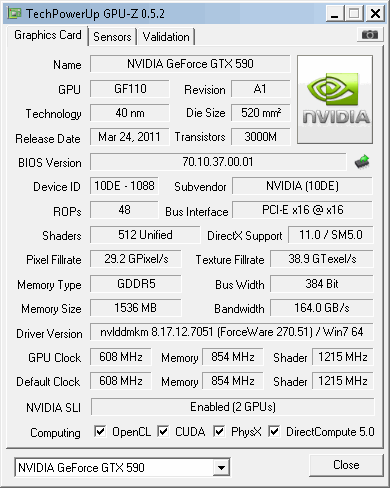
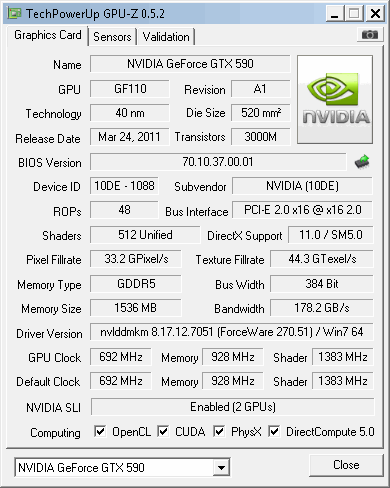
Of course, consumption is an important piece of the puzzle if you’re looking to set up a 590 Quad SLI, since you’ll need a 1100W PSU or even higher. After all, you don’t want to risk a €1200 setup.
Our test rig occasionally drew up to 1099W, which is quite a lot despite the fact that it’s a high end machine. Due to this, we opted on using Sapphire’s Pure 1250W PSU. To be fair though, EVGA’s 4xSLI motherboard also contributed to high consumption as it consumes more than most other Quad SLI ready boards.
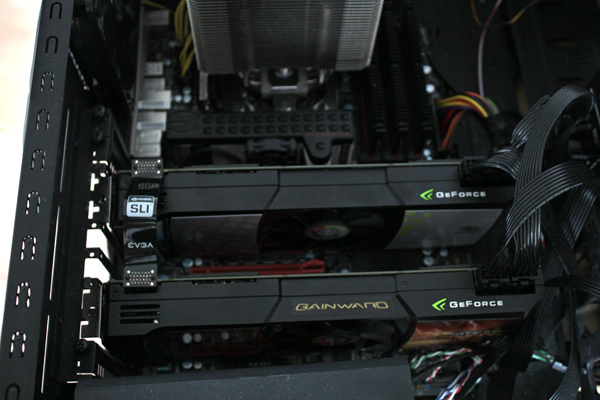
Next thing you need to address is the heat and two GTX 590 cards can definitely make some. You’ll need a large case with good airflow and a side panel fan wouldn’t hurt either to blow between the two GTX 590 cards. We used CoolerMaster’s HAF-X case.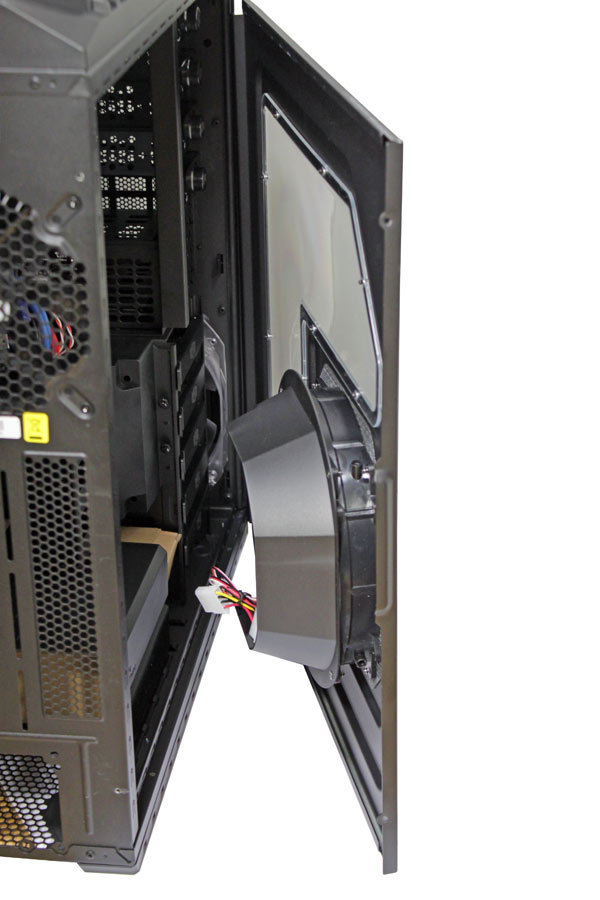
It was relatively cold outside during our testing, 15°C, while our room temperature was at 25°C. However, we had to ventilate the entire room quite often, because it quickly became stuffy. And that’s not all – a really unpleasant smell was emanating from brand new graphics cards as well as the PSU, which was also new and suddenly running full power.
We suppose that the smell should go away after a few days of usage, but we unfortunately didn’t have that much time. Namely, partners want their cards back since Nvidia didn’t provide enough.
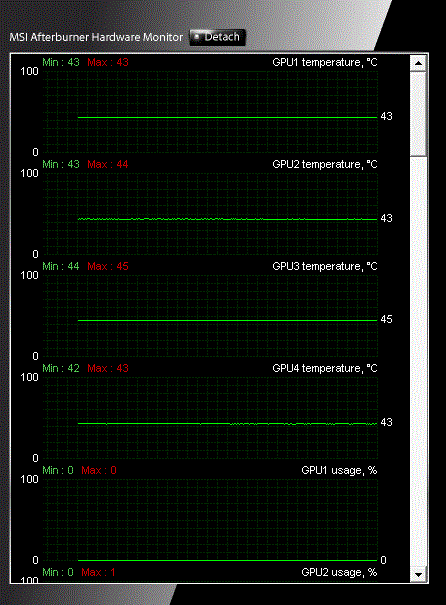
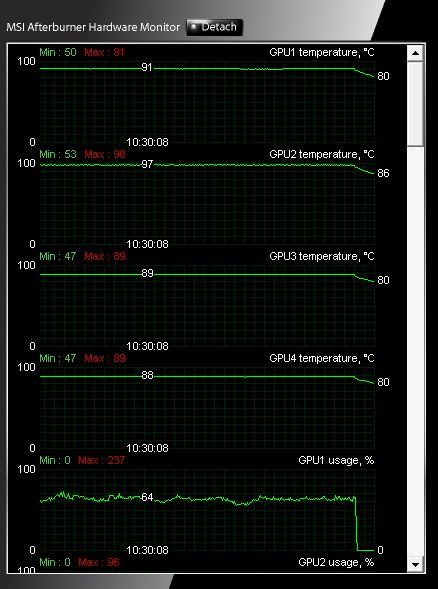

Using more than two displays on one graphics card has been AMD’s significant advantage, but the GTX 590 can finally allow Nvidia to offer a card with 3D Vision by default. The card as you remember comes with three dual-link DVIs and one mini-DisplayPort. With some VGA and HDMI converters, a GTX 590 user has all the video options at his disposal.
In Quad SLI mode, DVI #1 and #2 on each card must be used – the DisplayPort and DVI #3 outputs are not supported in this rendering mode ( Which means that Quad SLI also allows for maximum of four displays).
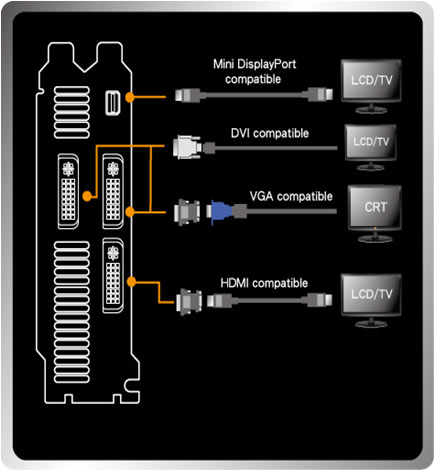
Testing
Aliens vs Predator, Unigine Heaven tessellation and Tess Mark testing went without a hitch but 3DMark 2011 refused to finish testing at Extreme settings several times. Then, we had some trouble in Metro 2033. We’ve seen that our colleagues from Tom’s Hardware managed to finish Metro 2033 at 2560x1600 4xAA and 16AF, but we couldn’t even start the benchmark. However, a single GTX 590 ran just fine.
We did not forget the HD 6990, we simply did not have two of them.
Aliens vs Predator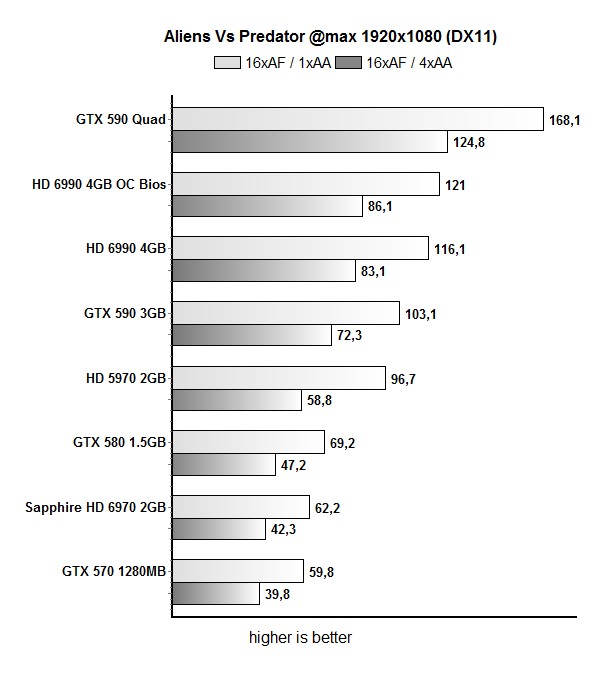
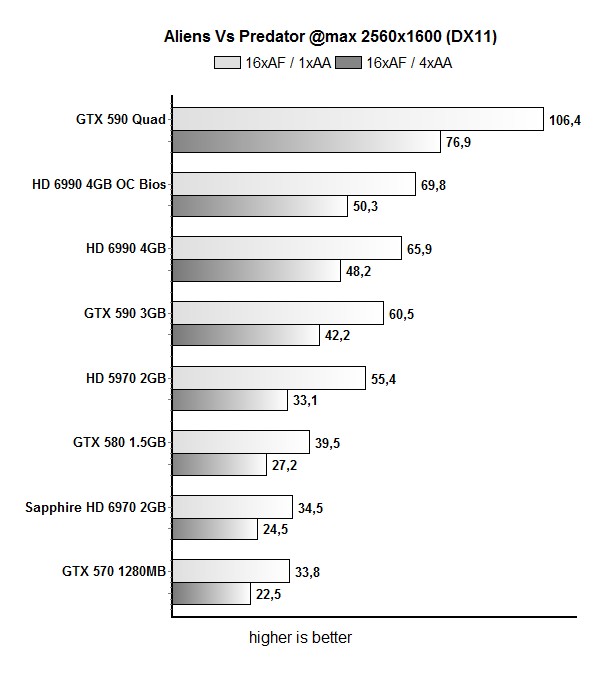
Metro 2033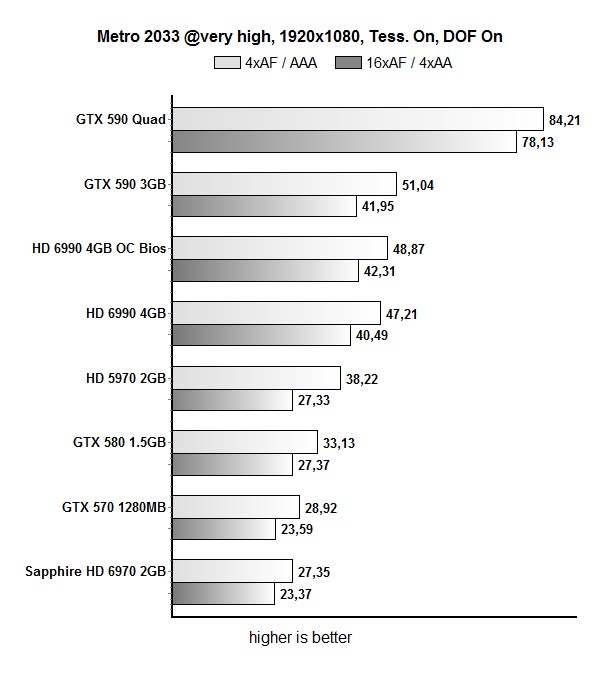
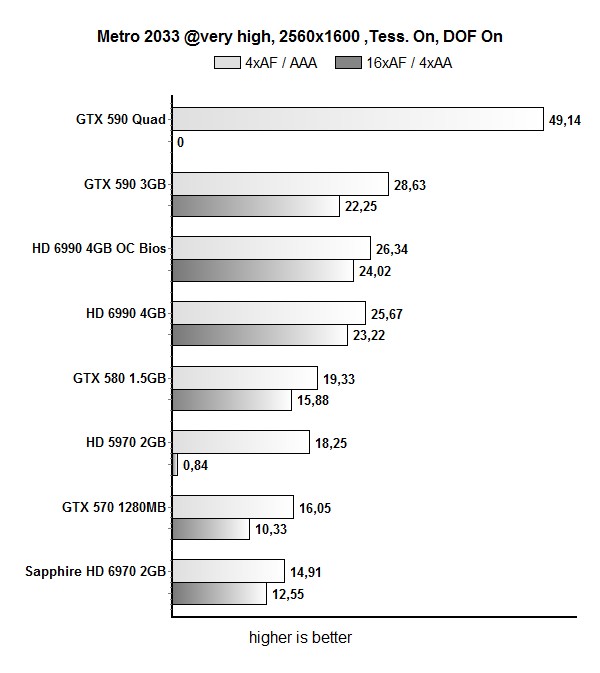
3DMark 2011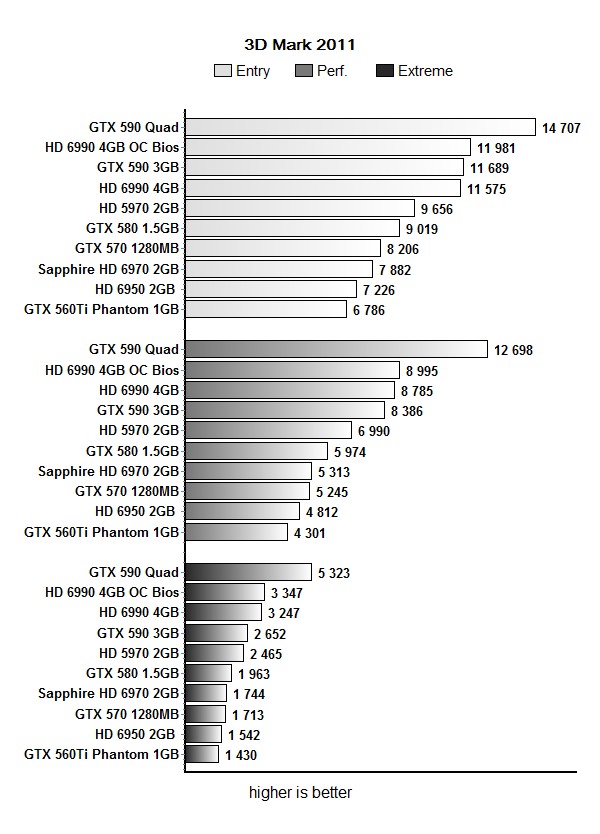
Unigine Heaven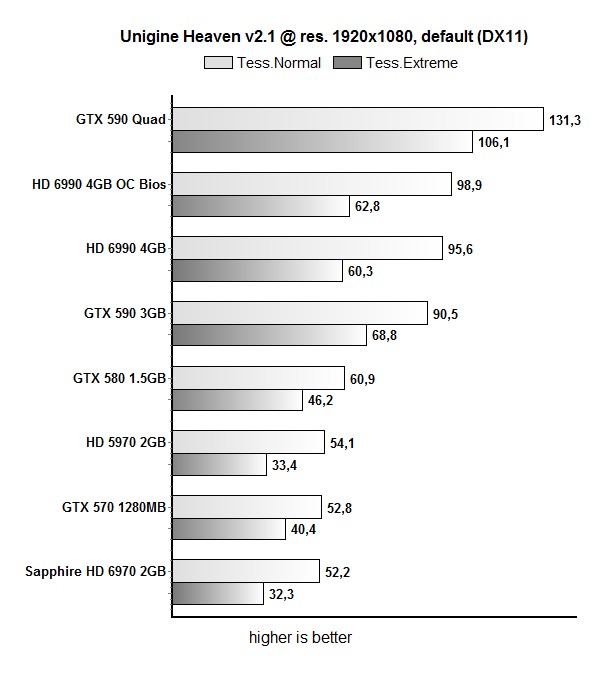
TessMark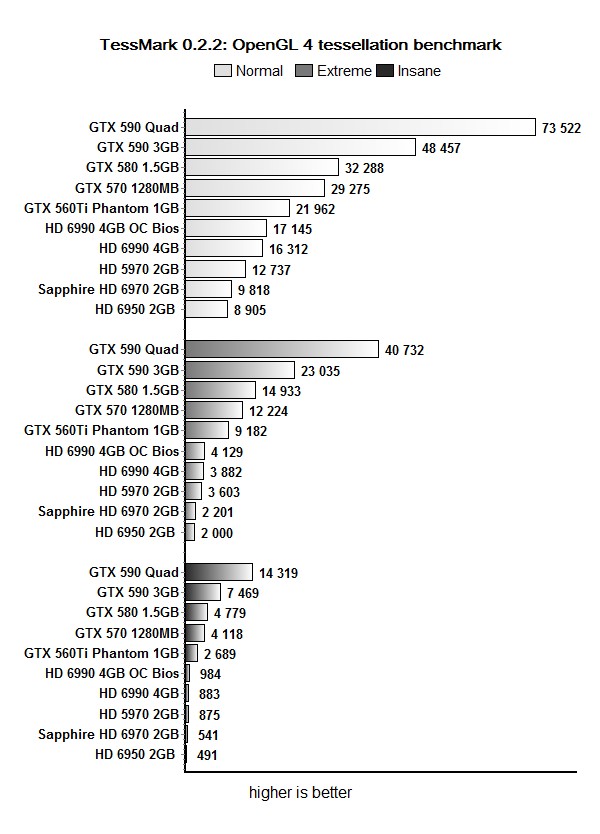
GTX 590 is a Fermi based, dual-GPU and DX11 card that does well in fighting HD 6990, but there is no clear cut winner as of yet. Unfortunately, we did not have the results scored by two HD 6990 cards, so that we could compare quad GPU rigs, but we can at least share our impressions of the GTX 590 Quad SLI rig.
Our machine had two GTX 590 cards that will cost about €1200. We must thank Gainward and Point of View / TGT who have kindly provided us with samples.
As far as performance goes, we’ve never seen something this fast. However, although Quad SLI sounds cool, most gamers will do just fine with a single GTX 590. Single GTX 590 performance is excellent and two cards will only make what’s already fast, into fast-er.
We must say, extraordinary performance aside, €1200 for two GTX 590 graphics cards is a bit too steep, regardless of how deep your pockets are. Two GTX 590 cards will not double your performance because it seems we have history repeating. Namely, scaling performance with four GPUs is far lower than with two. We had some trouble with a few tests - 3Dmark 2011 Extreme and Metro 2033 running at 2560x1600 and 4xAA i 16AF. We think that the problems are simply down to unfinished drivers.
Quad SLI will not require only two GTX 590 cards, you must have a good 1000W+ PSU and CPU, because your CPU may limit performance.
As far as noise goes, two GTX 590 cards didn’t make much more noise than with one GTX 590. That our rig was loud is true, but it’s not unbearable. Nvidia did a good job with reference cooling, but you still need to have a well ventilated and roomy case. If the temperatures exceed 97°C, the thermal threshold will kick in.
All in all, we don’t have many complaints about GTX 590 Quad SLI; Nvidia did a pretty good job, and we enjoyed some 2560x1600 gaming for a few hours.



